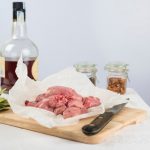Red wine drinking dries the palate and to conduct a seriously proper wine-tasting, most experts eat a dry biscuit between their sipping. That drying property of wine is more properly termed astringency and is produced by mainly tannins, polyphenols, anthocyanins and other chemical compounds that have come from the grape, especially its skins which then interact with proteins in the mouth (Jackson, 2000; Bajec & Pickering, 2008). It is one of the defining characteristics of a red wine in particular and contributes to its complexity, quality and sophistication (Peynaud, 1987). It is also one of the characteristics that determines market positioning and ultimately the price.

The ASTM (2004) in the United States defines astringency as “the complex of sensations due to shrinking, drawing or puckering of the epithelium as a result of exposure to substances such as alums or tannins”. Astringency is generally a time-dependent phenomenon in the mouth (Guinard et al., 1986a) and builds up with repeated imbibing of wine, beer or any other beverage that has ‘drying’ properties (Amerine and Roessler, 1983; (Guinard et al., 1986b). It seems the perception of dryness will increase linearly for the first 13 to 15 seconds after imbibing, regardless of the compound causing the dryness and its concentration (Ishikawa and Noble, 1995; Courregelongue et al., 1999; Colonna et al., 2004). Wine tasters though need to clear the palate for further tasting otherwise the sensory profile of the wine alters radically. To deal with this, it is not uncommon for tasters in any test for that matter to have a sip of water and have a morsel of dry water biscuit – a so called palate cleanser. However, which type of palate cleanser is best for the job ?
Palate cleansers and the way the mouth might be rinsed between tasting was studied not that long ago (Ross et al., 2007; Lee & Vickers, 2008, 2010). A recent study looked at a range of palate cleansers for evaluation against astringency created by red wine in particular and also to see if the level of astringency build-up could be lowered and minimise discrepancies between wine sampling. The scientists (Vidal et al., 2016) were based in the Instituto Polo Technologico de Pando of the Universidad de la Republica in Pando, Canelones, Uruguay.
Fourteen trained panelists evaluated two sets of four Tannat wine samples using the time-intensity methodology (Vidal et al., 2016. In the first sample set the same wine was presented four times, while the second one was made up of four samples with different added concentrations of added grape seed tannins. Each assessor evaluated both sample sets with five different palate cleansers that were made up of still mineral water, plain unsalted crackers, skimmed milk, a drinkable but plain sweetened yogurt and finally a 2 g/L pectin solution, and all in triplicate.

Their findings were perhaps not surprising given the findings of previous studies. None of the palate cleansers actually prevented the occurrence of build-up of astringency. It highlights the point that the number of wine samples to be tasted needs to be kept as low as feasibly possible. The additional feature is to have an appropriate time between tastings to allow the mouth to return to its normal salivary flow.
However, sample discrimination ability differed among the five palate cleansers considered which suggests that the tasters themselves as much as the cleansers have bearing on the sensory perception of the wine. When it came to sample discrimination, the drinkable but plain sweetened yogurt, followed by a water rinse, provided the best results compared to more typical enduring alternatives, a pectin solution or just plain water biscuits. In fact, the researchers quite bluntly state that the plain crackers, which have been recommended in other studies, showed the lowest discrimination.
Even though the authors suggest better practice in the art of wine tasting at least there is still individuality in this art.
Amerine, M.A. and Roessler, E.B. (1983) “Wines, Their Sensory Evaluation.” 2nd ed., Freeman, San Francisco, CA. USA.
ASTM. (2004). Standard Definitions of Terms Relating to Sensory Evaluation of Materials and Products. Annual Book of ASTM Standards, American Society for Testing and Materials, Philadelphia.
Bajec, M. R., & Pickering, G. J. (2008). Astringency: mechanisms and perception. Critical Reviews in Food Science and Nutrition, 48(9), pp. 858-875.
Colonna, A. E., Adams, D. O., & Noble, A. C. (2004). Comparison of procedures for reducing astringency carry‐over effects in evaluation of red wines. Aust. J. Grape and Wine Res., 10(1), pp. 26-31.
Courregelongue, S., Schlich, P., & Noble, A. C. (1999). Using repeated ingestion to determine the effect of sweetness, viscosity and oiliness on temporal perception of soymilk astringency. Food Qual. Preference, 10(4), pp. 273-279.
Guinard, J.-X., Pangborn R.M. Lewis, M.J. (1986a) Effect of repeated ingestion on temporal perception of bitterness in beer. Am. Soc. Brew. Chem. J. 44(1) pp. 28-32
Guinard, J. X., Pangborn, R. M., & Lewis, M. J. (1986). The time-course of astringency in wine upon repeated ingestion. Amer. J. Enology and Viticulture, 37(3), pp. 184-189.
Ishikawa, T., Noble, A.C. (1995) Temporal perception of astringency and sweetness in red wine. Food Qual. Preference 6 pp. 27-33
Jackson, R.S. (2000) “Wine Science: Principles, Practice, Perception” 2nd ed. Academic Press, San Diego, CA. USA.
Lee, C. A., & Vickers, Z. M. (2008). The astringency of whey protein beverages is caused by their acidity. Int. Dairy J. 18(12), pp. 1153-1156.
Lee, C. A., & Vickers, Z. M. (2010). Discrimination among astringent samples is affected by choice of palate cleanser. Food Qual. Preference 21(1), pp. 93-99.
Peynaud, E. (Trans. By M. Schuster) (1987) “The taste of Wine. The Art and Science of Wine Appreciation.” Macdonald and Co, London.
Ross, C. F., Hinken, C., & Weller, K. (2007). Efficacy of palate cleansers for reduction of astringency carryover during repeated ingestions of red wine. J. Sensory Studies, 22(3), pp. 293-312.
Vidal, L., Antúnez, L., Giménez, A. and Ares, G. (2016), Evaluation of Palate Cleansers for Astringency Evaluation of Red Wines. J. Sensory Studies. doi: 10.1111/joss.12194



My brother suggested I might like this website. He used to be totally right.
This publish actually made my day. You cann’t imagine simply how so much time I had spent for this info!
Thank you!